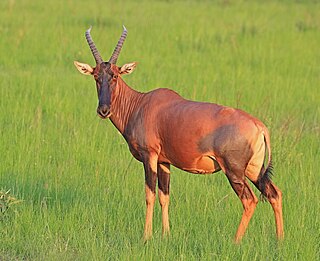
A lima bean, also commonly known as the butter bean, sieva bean, double bean or Madagascar bean is a legume grown for its edible seeds or beans.

The subfamily Alcelaphinae, of the family Bovidae, contains the wildebeest, tsessebe, topi, hartebeest, blesbok and bontebok, and several other related species. Depending on the classification, there are 6–10 species placed in four genera, although Beatragus is sometimes considered a subgenus of Damaliscus, while Sigmoceros is sometimes considered for the Lichtenstein's hartebeest.

The common tsessebe or sassaby is the southern, nominate subspecies of Damaliscus lunatus, although some authorities have recognised it as an independent species. It is most closely related to the Bangweulu tsessebe, sometimes also seen as a separate species, less to the topi, korrigum, coastal topi and tiang subspecies of D. lunatus, and less to the bontebok in the same genus. Common tsessebe are found in Angola, Zambia, Namibia, Botswana, Zimbabwe, Eswatini, and South Africa.

The white-naped honeyeater is a passerine bird of the honeyeater family Meliphagidae native to eastern Australia. Birds from southwestern Australia have been shown to be a distinct species, Gilbert's honeyeater, and the eastern birds are more closely related to the black-headed honeyeater of Tasmania. One of several similar species of black-headed honeyeaters in the genus Melithreptus, it dwells in dry sclerophyll eucalypt woodland. Its diet consists of nectar from various flowers, and it also feeds on insects.

The spectacled tern, also known as the grey-backed tern, is a seabird in the family Laridae.

The korrigum, also known as Senegal hartebeest, is a subspecies of the topi, a large African antelope.

Damaliscus lunatus is a large African antelope of the genus Damaliscus and subfamily Alcelaphinae in the family Bovidae, with a number of recognised geographic subspecies. Some authorities have split the different populations of the species into different species, although this is seen as controversial. Common names include topi, sassaby, tiang and tsessebe.

Cochliobolus lunatus is a fungal plant pathogen that can cause disease in humans and other animals. The anamorph of this fungus is known as Curvularia lunata, while C. lunatus denotes the teleomorph or sexual stage. They are, however, the same biological entity. C. lunatus is the most commonly reported species in clinical cases of reported Cochliobolus infection.

The silver-breasted broadbill is a species of bird in the broadbill family, Eurylaimidae. There are seven currently recognised subspecies; the other species in the genus Serilophus, the grey-lored broadbill, was also previously treated as being a subspecies of this species.
The moon-toothed degu is a species of rodent in the family Octodontidae. It is endemic to Chile, occurring in mountainous areas along the Pacific coast in the central part of the country.

Damaliscus lunatus jimela is a subspecies of topi, and is usually just called a topi. It is a highly social and fast type of antelope found in the savannas, semi-deserts, and floodplains of sub-Saharan Africa.

The plate fish is a flounder in the genus Bothus, found in the warmer parts of the Atlantic including the Caribbean. Its typical habitat is sandy plains near coral reefs and it is able to change its colouring to make it well-camouflaged in this environment. It is sometimes known as the peacock flounder, a name also given to the closely related Bothus mancus from the Indo-Pacific.

The Upper Zambezi labeo is a species of cyprinid fish of the genus Labeo native to southern Africa.

The Bangweulu tsessebe is a population and possible taxon of Damaliscus lunatus, which are large African antelopes of the grasslands. This population is presently restricted to northern Zambia in the wild, although it was recorded as occurring in neighbouring southernmost Democratic Republic of the Congo in the 1940s. Also seen as the northernmost population belonging to the nominate southern sassaby subspecies, in 2003 it was described as a new species, only to be downgraded to a subspecies a few years later. Its taxonomic status is unclear as of 2021. As an individual sassaby of this taxon cannot be clearly distinguished from populations to the south, the taxon was defined using an experimental suite of statistical techniques applied to a sample set, based on multivariate analysis, and recognised under an experimental new taxonomy. Nominate sassaby antelopes become progressively darker on average in the northern populations, and on average have a slightly thicker horns at the base of the skull, but those of northern Zambia are the darkest and with the most robust horns on average.

Deudorix antalus, the brown playboy, is a butterfly of the family Lycaenidae. It is found in Africa and south-west Arabia.
The tiang is a subspecies of the topi, an African antelope.
The coastal topi is a highly social antelope of the genus Damaliscus. It is a subspecies of the topi.

Menenotus is a genus of leaf-footed bug in the Coreinae subfamily.

Triepeolus lunatus is a species of cuckoo bee in the family Apidae. It is found in North America from Canada to northern Mexico. Triepeolus lunatus tends to live in forest edges and meadows.

Biphyllus lunatus is a species of beetle in the family Biphyllidae.
















